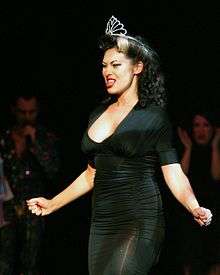Shimmy

A shimmy is a dance move in which the body is held still, except for the shoulders, which are alternated back and forth. When the right shoulder goes back, the left one comes forward. It may help to hold the arms out slightly bent at the elbow, and when the shoulders are moved, keep the hands in the same position. In 1917, a dance-song titled "Shim-Me-Sha-Wabble" by Spencer Williams was published, as was "The Jazz Dance", which included the "Shimmy-She", among others.
"I Wish I Could Shimmy Like My Sister Kate" was an up-tempo jazz dance song, written by Clarence Williams and Armand Piron, and published in 1919 which has been enduringly popular ever since and performed and recorded by many artists.[1]
Flappers often performed the dance in the 1920s. The origin of the name is often attributed to Gilda Gray, a Polish emigrant to America. An anecdote says that when she was asked about her dancing style, she answered, in heavy accent, "I'm shaking my chemise". However, in an interview Gilda denied having said this, and earlier usages of the word are recorded. In the late 1910s others were also attributed as being the "inventor" of the shimmy, including Bee Palmer. Mae West, in her autobiography Goodness Had Nothing to Do with It, claimed to have retitled the "Shimmy-Shawobble" as the Shimmy herself, after seeing the moves in some black nightclubs.
The dance was often considered to be obscene and was frequently banned from dance halls during the 1920s.[2]
The move is also known under different names in various folk dances, in Gypsy dances. In Russian this move is called "Tsyganochka", or "gypsy girl", and is done by gypsy female dancers to produce a chime of costume decorations made of the sewn-on coins.
The dance move with this name is used in various modern dances.
The shimmy is also a class of belly dance moves. Depending on the desired effect, style, teacher, and country of origin of the particular dance, a shimmy might be executed differently, but altogether, the shimmy will manifest as a fast shaking or shuddering movement that can be rhythmic or arrhythmic. The movement may be localized, such as in the hips, shoulder, chest, etc., or the move might be loose and general, reverberating through the entire body. Shimmies in belly dance can also have orientation, such as an up/down movement or a twisting movement of the hips.
Cultural references
- Bee Palmer first attracted significant attention as one of the first exponents of the shimmy in the late 1910s. She was sometimes credited as the creator of the "shimmy" (although there were other claimants at the time as well).
- Tina Turner asks the question "Do you want to see me do the shimmy again?" in the song Private Dancer.[3]
External links
- Shimmy at "Dance History Archives"
General references
- ↑ "Original Memphis Five - I Wish I Could Shimmy Like My Sister Kate". You Tube. 11 September 1922. Retrieved November 2015.
- ↑ "The Roaring Twenties - Dancing The Shimmy". YouTube. 1920s.
Press reports on banning at 0:55 and 1:16
- ↑ "Tina Turner - Private Dancer (Live) (Tina Turner) Lyrics". Songlyrics.com. 1966-03-07. Retrieved 2014-08-22.